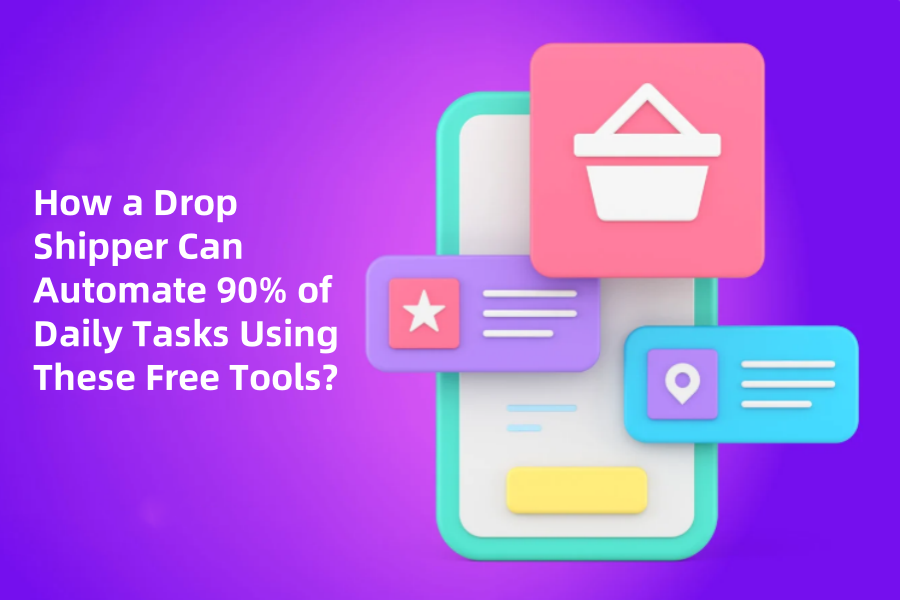How a Drop Shipper Can Automate 90% of Daily Tasks Using These Free Tools
For a drop shipper, time is money. Juggling product research, order processing, customer messages, and inventory checks can eat up hours each day—time better spent growing your business. The good news? Free tools can automate most of these tasks, letting you focus on strategy instead of repetition. Here’s how to use these tools to streamline 90% of your daily work, from finding winning products to handling customer questions.
Product Research and Inventory Management
Finding the right products to sell and keeping track of stock levels are two of a drop shipper’s biggest daily chores. Free tools can take over both, ensuring you pick trending items and never oversell.
Product discovery tools like Dropship Spy and Dropship.io use AI to scan social media (TikTok, Instagram) and e-commerce platforms for products gaining traction. They analyze engagement, sales trends, and competition, then suggest items with high profit potential. For example, if a “portable cold brew maker” is getting 50% more searches than last month, these tools will flag it—saving you hours of manual research. A drop shipper can set up daily alerts to get a list of top picks, so you always know what to add to your store.
Inventory sync tools like Inventory Source and DSers connect your store to suppliers (AliExpress, Oberlo). They automatically update stock levels, prices, and product details. If a supplier runs out of an item, your store marks it “out of stock” instantly—no more manually checking each listing. DSers, which is free for up to 3,000 products, also lets you bulk-import items and assign backup suppliers, so you’re never stuck if one runs low.
For price changes, use Zapier (free for basic use) to build simple workflows. For example: “If a supplier raises their price by 10%, automatically increase my store price by 15% to keep margins steady.” This takes 5 minutes to set up and runs forever, saving you from daily price checks.
Order Fulfillment
Processing orders one by one—copying addresses, paying suppliers, updating tracking numbers—can take hours. Free tools turn this into a hands-off process.
One-click fulfillment tools like DropKit and Dropified integrate directly with your store and suppliers. When a customer buys something, DropKit automatically sends the order to your supplier, pays for it, and even adds a note (like “Please include a thank-you card”). It then pulls the tracking number and updates your store, so the customer gets a shipping alert without you lifting a finger. Dropified, which works great with AliExpress, does the same and lets you save “favorite” suppliers to speed up repeat orders.
For drop shippers who mix drop shipping with holding some inventory (a hybrid model), Ordoro (free for small stores) is a game-changer. It sorts orders: if the item is in your local warehouse, it sends the order there; if it’s drop shipped, it goes to the supplier. This cuts shipping times for popular items and reduces mistakes, as Ordoro handles all the coordination.
Customer Service
Answering the same questions (“Where’s my order?” “Can I return this?”) 20 times a day drains energy. AI chatbots and automated emails handle this for free.
AI chatbots like Tidio and Ochatbot live on your store and answer FAQs 24/7. Tidio’s free plan lets you set up responses to common queries: “Your order ships in 3–5 days” or “Returns are accepted within 30 days.” It can even suggest related products—like offering a phone case to someone who bought a screen protector—boosting sales. Ochatbot learns from conversations over time, so its answers get smarter, reducing the need for you to step in.
Automated emails from Mailchimp (free for up to 2,000 subscribers) keep customers in the loop without you writing a single message. Set up workflows like:
- Send a “Thanks for your order!” email with tracking info 1 hour after purchase.
- Remind customers of abandoned carts with a 10% discount after 24 hours.
- Follow up 1 week later to ask for a review (and offer a discount on their next buy).
These emails recover lost sales (studies show abandoned cart emails win back 15–20% of customers) and build loyalty—all on autopilot.

Marketing and Social Media
Creating ads, posting on social media, and writing product descriptions take time, but free tools can automate most of it.
Content generators like Dondo turn product photos into ready-to-use descriptions and social posts. Upload a picture of a reusable water bottle, and Dondo writes a TikTok caption: “Stay eco-friendly on the go—this leak-proof bottle fits in any bag!” It even adds hashtags like #SustainableLiving. Amasty AutoPost (free for basic use) then posts these to Instagram or Facebook at the best times (like 7 PM when your audience is active), so you don’t have to schedule manually.
Social commerce tools like Amplorium track which posts drive sales and auto-repost your top-performing content. Dropship Spy also gives you free ad templates—short videos or images that have already proven to work for similar products. Just swap in your store’s details and run the ad—no design skills needed.
Data and Profit Tracking
Wasting time crunching numbers to see what’s selling? Free analytics tools turn data into clear insights.
Google Analytics 4 (free) shows where your customers come from (TikTok? Google?) and which products get the most clicks. For example, if 60% of sales come from Instagram, you’ll know to double down on that platform. Dropship.io (free trial) lets you spy on competitors—see what they’re selling, how much they charge, and which ads are working—so you can adjust your strategy fast.
For profit checks, use Dropshipping.com’s free profit calculator. Plug in supplier costs, shipping fees, and your selling price, and it tells you your margin. A $30 shirt with $8 in costs and $5 shipping? That’s a 57% margin—no more manual math.
Staying Compliant
Taxes, data privacy, and customs rules can trip up a drop shipper, but free tools handle the paperwork.
TaxJar (free for small stores) auto-calculates sales tax for U.S. orders, so you charge the right amount for each state. Shopify Tax (built into Shopify, free for basic use) does the same for EU VAT, making sure you follow rules like charging 20% VAT for UK customers.
For data privacy (GDPR, CCPA), DelightChat’s free GDPR tool adds a cookie consent banner to your store and lets customers delete their data with one click—keeping you legal without the stress.
FAQ
Do I need tech skills to use these tools?
No. Most tools (like Tidio, DSers, and Mailchimp) have drag-and-drop setups. You don’t need to code—just follow the step-by-step guides.
Can I automate everything for free?
Nearly everything. The free plans cover most small to medium drop shipping stores. If you grow, you might need to upgrade, but by then, the time saved will pay for it.
How long does it take to set up automation?
Most tools take 30 minutes to 2 hours to set up. Once done, they run automatically. You’ll spend less than 1 hour a week checking in, freeing up time for big-picture work like finding new suppliers or testing ad campaigns.
Will automation hurt customer service?
No—in fact, it improves it. Chatbots answer questions instantly, and automated emails keep customers updated. You’ll only step in for complex issues, making your responses faster and more focused.
Which tool is most important for a new drop shipper?
Start with DSers for order fulfillment and Tidio for chat support. These two handle the most time-consuming tasks, giving you quick wins as you learn the ropes.


